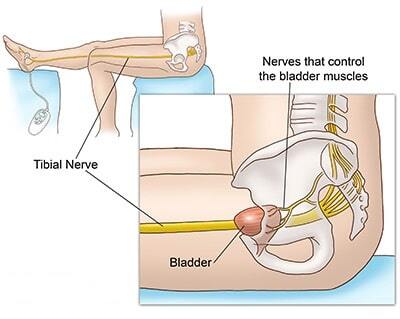Urgent® PC Kansas City
Urinary incontinence, no matter how minor or infrequent it may seem, can be an embarrassing and uncomfortable issue. If you’re having problems with bladder control, Patrick Nosti, MD, FACOG at Urogynecology of Kansas City, can help. Book your incontinence evaluation in our main office or at a satellite location.
UROGYNECOLOGY OF KANSAS CITY | 913.262.3000

PTNS (Percutaneous Tibial Nerve Stimulation)
A Guide for Women
- What is Overactive Bladder (OAB)?
- How does PTNS work for OAB?
- How effective is PTNS for OAB?
- What are the risks?
- What can I expect during the procedure?
- Contraindications
What is Overactive Bladder (OAB)?
Overactive bladder is a common condition caused by an involuntary contraction of the bladder muscle (detrusor) leading to urinary frequency, urgency, nighttime voiding, and leakage of urine. This can have a significant impact on your quality of life.
How does PTNS work for OAB?
PTNS is used in patients who have not gotten relief from medications or other therapies. It is a non-surgical and low risk option. PTNS works by indirectly providing electrical stimulation to the nerves responsible for the bladder and pelvic floor function.

How effective is PTNS for OAB?
Studies show that PTNS is effective for 60-80% of patients. The benefits of PTNS occur gradually, it may be several weeks before you start to notice your symptoms improving. Our goal is to see a 50% reduction in your urinary symptoms after a series of 12 PTNS sessions. This may mean less urinary leakage, less frequent urination, and/or fewer nighttime voids. It is rare that all of your symptoms resolve. You may need to maintain these results with periodic maintenance PTNS sessions.
What are the risks?
PTNS has no serious adverse reactions reported. You may experience a mild discomfort, localized bleeding, or bruising or redness at the insertion site.
What can I expect during the treatment?
You will sit with your leg elevated. A slim needle will be inserted near the tibial nerve at the ankle. A stimulator device is connected to the needle which sends a mild electrical impulse to the tibial nerve. These impulses travel to the sacral nerve plexus, the group of nerves at the base of the spine responsible for bladder function. Each session will last 30 minutes. After the treatment time the needle will be removed and you can resume your daily activities.
Contraindications:
While PTNS is safe for most patients, there are some who should not receive it.
- Patients with pacemakers or implanted defibrillators
- Patients prone to excessive bleeding
- Patients with nerve damage that could affect tibial nerve or pelvic floor function
- Women who are pregnant or planning on becoming pregnant during the duration of the therapy.
